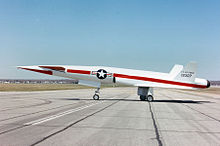North American X-10
The North American X-10 was, like the Bell X-9 , a technology demonstrator for advanced missile technology .
The development of a long-range surface-to-surface missile at North American led to the RTA-A-5 , which was later renamed the X-10 and had its maiden flight on October 14, 1951. The last offspring of the X-10 was the SM-64 Navaho ICBM .
The X-10 was powered by two jet engines and could take off and land like a normal airplane . The fully articulated canards and delta wings were later also used on the SM-64 Navaho. The X-10 was controlled with a radio control system and had an autopilot to ensure a stable flight attitude. Later the X-10 were equipped with an internal navigation system.
At the time, the X-10 was the fastest jet- powered aircraft and reached a top speed of Mach 2.05. The program was carried out with great success until testing on the SM-64 Navaho began in November 1956. In 1955 the program was moved to Cape Canaveral , where flight attempts were resumed until 1959. Of the 13 X-10s built, only one survived, which is on display in the National Museum of the United States Air Force in Dayton, Ohio . The others were destroyed in accidents on landing or as target drones .
General data
| Parameter | Data |
|---|---|
| First flight | October 13, 1951 |
| Manufacturer | North American Aviation |
| span | 8.59 m |
| length | 21.64 m |
| height | 4.4 m |
| Takeoff weight | 18,100 kg |
| crew | 0 |
| Top speed | 2,090 km / h |
| Service ceiling | 13,720 m |
| Range | 400 km |
| Engines | 2 Westinghouse XJ40-WE-1 |
Individual evidence
- ↑ Description on history.nasa.gov p. 16. (PDF; 1.2 MB) Retrieved on January 14, 2013 .

